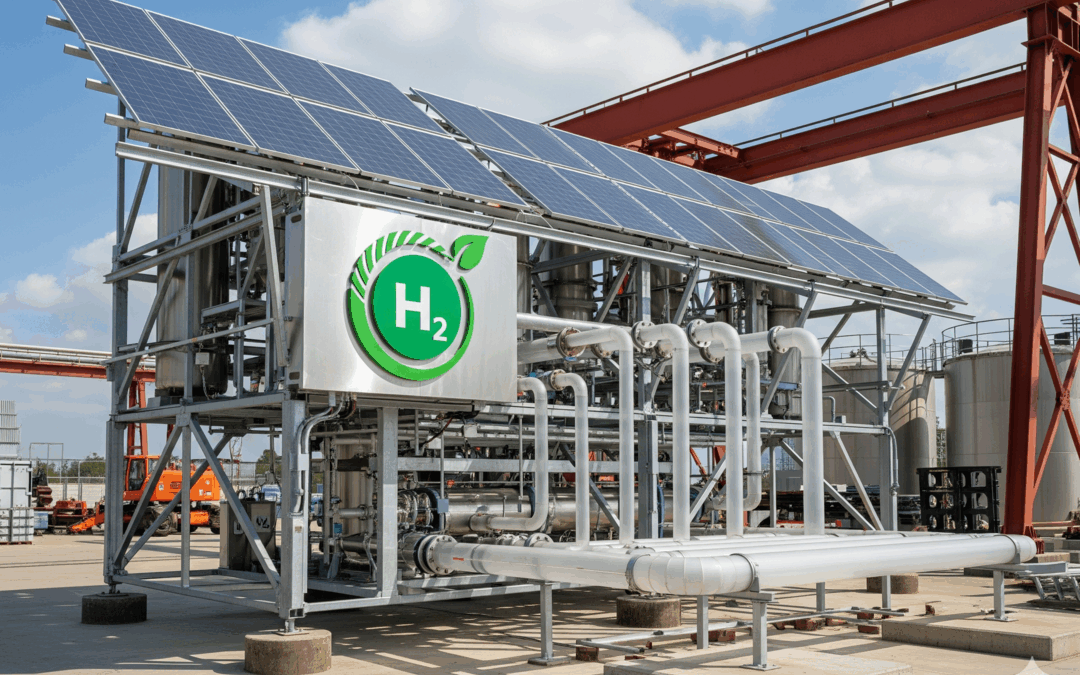Scientists Exhibit Device Producing Green Hydrogen from Air in Arid Regions
Scientists unveil solar-powered device producing green hydrogen from air, enabling clean energy in arid, water-scarce regions.
Researchers from Griffith University in Australia, the Chinese Academy of Sciences, and Queen’s University Belfast have developed a solar-driven device that generates green hydrogen directly from atmospheric moisture.
The system, which functions in areas with relative humidity as low as 20 percent, represents a significant step toward sustainable hydrogen production in water-scarce regions.
Breakthrough in Hydrogen from Air
The study, published in Advanced Materials, describes an integrated process that combines atmospheric water harvesting with proton exchange membrane water electrolysis.
The approach enables the production of hydrogen using only sunlight and air as inputs. During outdoor trials in Queensland, Australia, the device reached a midday peak of 204 milliliters of hydrogen per hour without external power or freshwater supply.
Bo Fu, the paper’s lead author, said the technology is designed to solve two pressing challenges: clean energy generation and water scarcity. “Our system enables high-purity hydrogen generation without freshwater or carrier gases, which is essential for deployment in arid environments,” Fu said.
The porous carbon material at the core of the device showed a record water harvesting capacity of 0.49 liters per kilogram per hour at 40 percent relative humidity.
Unlike conventional materials, it remained effective under ultra-low humidity, continuing to operate at 20 percent relative humidity. That ability broadens the scope of where green hydrogen can be produced.
Engineering a New Carbon Material
The system’s success depends on the performance of a specially engineered hydrophilic ordered porous carbon. The carbon was created by introducing oxygen-containing functional groups that increase water affinity.
It was also designed with interconnected pores of different sizes, which improve both moisture capture and transport.
Scanning electron microscopy confirmed the material’s structure, while spectroscopy revealed enhanced hydrophilicity after calcination. The water contact angle dropped from 87 degrees to 20 degrees, a sign of greater wettability.
Tests showed that the material absorbed over 98 percent of incoming light across a wide spectrum. This enabled rapid heating and efficient solar-to-thermal conversion, critical for releasing water vapor under direct sunlight.
Fu explained that these advances were crucial for system performance. “The unique structure allows faster water adsorption and efficient solar-driven release. This dual capability ensures reliable hydrogen output even when environmental conditions are challenging,” he said.
Integrated Device Demonstrates Stability
The team built a custom electrolyzer that couples the porous carbon with a proton exchange membrane. The device operates in three stages: water uptake from the air, solar-driven vapor release and electrochemical hydrogen generation. In laboratory tests, hydrogen output reached nearly 300 milliliters in a 60-minute cycle.
Although hydrogen production using atmospheric water showed lower current density than pure water electrolysis, gas purity remained high. The researchers noted that the hot vapor produced through solar evaporation eliminated the need for additional heating elements, reducing energy costs.
Outdoor experiments in Southeast Queensland confirmed the system’s durability under natural sunlight. Environmental conditions varied from 22 to 29 degrees Celsius with humidity levels between 33 and 60 percent.
Hydrogen production tracked solar intensity, peaking at midday when radiation reached 0.77 kilowatts per square meter. The system continued operating consistently throughout the day despite fluctuations in the weather.
Such results highlight the potential of this self-sustaining process. The device requires no carrier gases or external power sources, making it practical for use in remote or off-grid areas. Its reliance on renewable resources allows hydrogen to be produced with zero carbon emissions across the production cycle.
Tackling the Water Challenge in Hydrogen
Conventional hydrogen production methods, even when powered by renewable electricity, depend on high-purity water as a feedstock. This requirement limits deployment in many regions already experiencing water shortages.
Large-scale electrolyzer projects often turn to desalinated water, a process that increases costs and energy demand.
By contrast, the Griffith-led team’s approach circumvents this constraint by sourcing moisture directly from the air. Comparative analysis showed that the new system outperformed other solar-driven electrolysis devices, which generally require humidity levels above 60 percent.
The ability to operate at just 20 percent humidity sets a new benchmark for hydrogen technologies.
“This integrated pathway addresses water scarcity while producing renewable fuel,” Fu said. “It opens the door for practical applications in arid and semi-arid areas where water-intensive technologies are not viable.”
The study positions green hydrogen as a more accessible energy carrier in regions that face both climate stress and limited freshwater. It also strengthens arguments for hydrogen’s role in decarbonizing industries such as steel, cement, and transportation.
Toward Large-Scale Deployment
The researchers emphasized that the materials used to fabricate the porous carbon are cost-effective and scalable. Manufacturing involves zeolitic imidazolate frameworks and simple thermal treatments, which can be replicated on larger scales. This suggests the approach could be commercialized for industrial or regional energy needs.
Hydrogen production via this method could also complement other renewables. The electrolyzer can be powered not only by solar panels but also by wind or tidal energy. Such flexibility improves its prospects for integration into diverse energy systems.
Global demand for hydrogen is projected to rise sharply as governments pursue net-zero targets. According to the International Energy Agency, hydrogen demand could more than double by 2050 under scenarios aligned with climate goals.
However, less than 1 percent of today’s supply comes from green hydrogen, with the vast majority produced from natural gas and coal.
Fu said more work is needed to move the technology from laboratory trials to real-world applications. “Our experiments demonstrate feasibility, but scaling up requires further research on durability and efficiency under varied conditions,” he said.
Still, the results mark an important milestone in the field. By combining atmospheric water harvesting and solar-driven electrolysis into one compact system, the project shows how hydrogen can be produced sustainably in areas once considered unsuitable for such technologies.
The work was supported by the National Natural Science Foundation of China, the Australian Research Council, and the Collaborative Innovation Program of Hefei Science Center, among others.
Also Read:
Cornell-Led Team Uses Sunlight, Seawater to Make Low-Cost Green Hydrogen
Nirmal Menon
Related posts

Subscribe
Error: Contact form not found.


